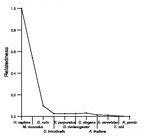
| Name: PTTG2 | Sequence: fasta or formatted (191aa) | NCBI GI: 154354976 | |
|
Description: pituitary tumor-transforming 2
|
Referenced in:
| ||
|
Composition:

Amino acid Percentage Count Longest homopolymer A alanine 7.3 14 2 C cysteine 1.0 2 1 D aspartate 5.2 10 2 E glutamate 7.9 15 2 F phenylalanine 5.2 10 2 G glycine 5.2 10 1 H histidine 1.0 2 1 I isoleucine 3.7 7 1 K lysine 10.5 20 2 L leucine 9.4 18 2 M methionine 2.1 4 1 N asparagine 2.1 4 1 P proline 9.9 19 2 Q glutamine 2.6 5 1 R arginine 4.2 8 2 S serine 8.4 16 2 T threonine 5.8 11 1 V valine 6.3 12 1 W tryptophan 0.5 1 1 Y tyrosine 1.6 3 1 |
Comparative genomics:
Search single species RefSeq proteins at NCBI
Search summary 
Figure data | ||
Related human proteins:Protein Relative score Description Self-match 1.000 pituitary tumor-transforming 2 PTTG1 0.805 pituitary tumor-transforming protein 1 CKAP2L 0.025 cytoskeleton associated protein 2-like SIM2 0.022 single-minded homolog 2 long isoform SIM2 0.022 single-minded homolog 2 short isoform LOC100288540 0.014 PREDICTED: hypothetical protein XP_002342775 TCOF1 0.014 Treacher Collins-Franceschetti syndrome 1 isoform f... TCOF1 0.014 Treacher Collins-Franceschetti syndrome 1 isoform e... TCOF1 0.014 Treacher Collins-Franceschetti syndrome 1 isoform d... TCOF1 0.014 Treacher Collins-Franceschetti syndrome 1 isoform b ... TCOF1 0.014 Treacher Collins-Franceschetti syndrome 1 isoform a ... TCOF1 0.014 Treacher Collins-Franceschetti syndrome 1 isoform c ... SPEN 0.011 spen homolog, transcriptional regulator POM121C 0.011 POM121 membrane glycoprotein (rat)-like KIAA1217 0.011 sickle tail isoform 3 KIAA1217 0.011 sickle tail isoform 2 MAPRE1 0.011 microtubule-associated protein, RP/EB family, member ... PCLO 0.011 piccolo isoform 2 PCLO 0.011 piccolo isoform 1 POM121 0.011 nuclear pore membrane protein 121 KIAA1217 0.008 sickle tail isoform 1 ANK2 0.008 ankyrin 2 isoform 1 RFC1 0.008 replication factor C large subunit MUC16 0.008 mucin 16 DEK 0.008 DEK oncogene isoform 2 DEK 0.008 DEK oncogene isoform 1 BRDT 0.008 testis-specific bromodomain protein BRDT 0.008 testis-specific bromodomain protein KIF26B 0.008 kinesin family member 26B DTX2 0.008 deltex 2 isoform aHuman BLASTP results (used to prepare the table) | |||
Gene descriptions are from NCBI RefSeq. Search results were obtained with NCBI BLAST and RefSeq entries. When identical proteins are present, the self-match may not be listed first in BLASTP output. In such cases, the table above has been reordered to place it first.
See About the Figures for the scoring system used in the figure above right. The same scoring system was used in the table of BLASTP results.
Guide to the Human Genome
Copyright © 2010 by Stewart Scherer. All rights reserved.
